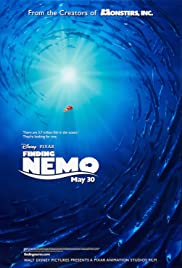
Magical. God knows how they do it, but Pixar is easily the most consistent, most intelligent movie shop in Hollywood. Their movies are loaded with razor sharp wit, mind-boggling visuals, pitch perfect casting, and an abundance of heart. If Disney knows what’s good for them, they will go to the negotiating table early (“Nemo” is the last movie in their current deal together) and give Pixar whatever they want in order to keep distributing their movies.
“Finding Nemo” had a lot to live up to: Pixar’s last movie, “Monsters Inc.,” was one for the ages, a dazzlingly clever and touching story that showed Pixar at the height of their powers. “Nemo,” by comparison, doesn’t quite strike the same emotional chord, but it doesn’t miss by much, either. And the advancements they’ve made with the visuals more than make up for any shortcomings in storytelling.
The story begins on the Great Barrier Reef, with a nervous clown fish named Marlin (voiced by Albert Brooks). His wife is cruelly dispatched in the first five minutes (what is it with Disney movies and dead mothers?), leaving him to raise his only surviving son Nemo (Alexander Gould). Nemo, now ready to start school and smothered by his overprotective father, dares to swim over the ledge of the reef in a fit of textbook rebellion, and pays for it dearly when a scuba diving dentist catches Nemo and brings him back to Sydney to put in his aquarium. Marlin rushes off to rescue his son, and along the way he meets Dory (Ellen Degeneres), a blue tang fish with short-term memory loss who tries to help him but naturally causes an equal amount of hindrance.
The one aspect of “Nemo” that will likely be overlooked upon viewing but remarked upon in retrospect is how spectacular the water looks. Animators will tell you how hard it is to capture the essence of water, both in terms of its movement and its tendency to be both murky and transparent, and the Pixar guys just nailed it. There are scenes with cascading water that look like real photography. Indeed, if there’s anything the artists haven’t figured out how to animate yet, it’s humans, who still look a bit like crash test dummies. Pixar picks their non-human subjects (toys, bugs, monsters, fish) for a reason, after all. Shhhhh. They’re easier to draw.
The importance of the casting cannot be overestimated. Brooks is a natural as worrywart Marlin, but it’s DeGeneres who absolutely steals the movie. Her Dory is dead on the money, possessing an ignorant bliss that someone who is both excitable and extremely forgetful would have. Watching her drive Brooks’ character up the wall is both fun and necessary, because Marlin alone would not have been much fun to watch.
What makes the Pixar movies truly special, however, are the supporting characters. Every Pixar movie has them. “Toy Story” had the Army men. “A Bug’s Life” had the Russian acrobatic bugs Tuck and Roll. “Monsters, Inc.” had Roz and the snakes in Celia’s hair. “Finding Nemo” has a laundry list of strong support, from Allison Janney’s starfish and Brad Garrett’s blowfish to Barry “Dame Edna” Humphries’ great white shark Bruce (a nice in-joke for “Jaws” aficionados) and Geoffrey Rush’s sympathetic pelican. But the best support in “Nemo” comes from the seagulls, whose endless squawk of “Mine? Mine? Mine?” (because really, isn’t that the only word seagulls really use?) makes them the center of attention every time they’re onscreen. They also have an uncanny resemblance to the penguin from “The Wrong Trousers,” for you Wallace & Gromit fans.
“Finding Nemo” is not perfect, however. The movie’s not very subtle with its vegetarian message, and there are a few bits in the first thirty minutes where the pacing drags noticeably. It seems they have their eyes more on the details (for example, watch Bruce’s eyes when he smells blood) than the big picture, and while that’s commendable in the face of so many movies that paint with very broad strokes (“Dumb & Dumberer,” anyone?), it works much better when there’s a coherent, well-paced story for those details to fit into.
“Finding Nemo” is proof positive that Pixar doesn’t make kids movies. That would imply that they’re only for the children to enjoy, while the parents sit utterly bored and insulted. No, Pixar makes family movies, ones that the kids, parents, grandparents and even sullen teenagers can enjoy. Half the attendees at the showing I saw were young couples in their 20s, which is money, baby. And rightfully so: Pixar hasn’t missed yet, and based on the hilarious trailer for their next movie, “The Incredibles,” there is no reason to suspect the next one will be any lesser. Bravo, gents.
 (4.5 / 5)
(4.5 / 5)



